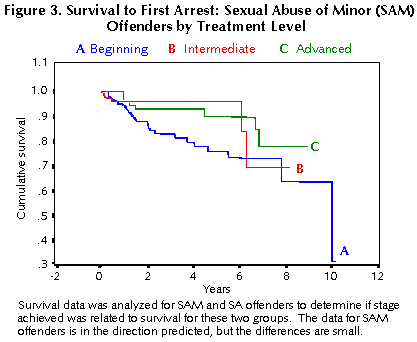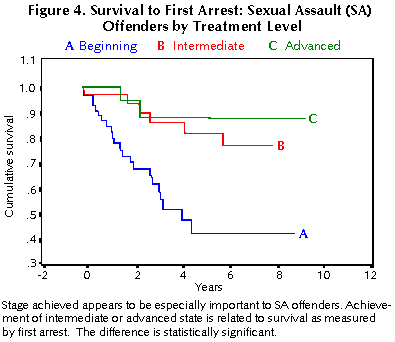
|
Note: For copies of the complete report Sex Offender Treatment Program: Initial Recidivism Study contact Rose Munafo at the Alaska Department of Corrections, (907) 269-7416.
IntroductionThe Alaska Department of Corrections, in conjunction with the University of Alaska Anchorage Justice Center, recently completed a study of sex offenders in the treatment program at Hiland Mountain Correctional Center during the period of January 1987 to August 1995. The study included analysis of descriptive characteristics of the participants; treatment variables such as length of time in program, reason for discharge and treatment stage at discharge; and re-offense data. The treatment group was compared with three other groups, including a motivated control group, an unmotivated control group, and a group of non-sex offenders (generics). There were several significant findings from the study:
|


Scope of the StudyThis analysis of sex offenders who have received treatment through the Department of Corrections involved the creation of a workable database, complex data compilation and interpretation of statistical information. The study was limited in scope to the extent that only sex offenders who participated in treatment at Hiland Mountain SOTP were included. The study did not address sex offenders who received treatment through other Department sex offender treatment programs, either in an institution or community setting. It also did not address sex offenders who received treatment for other presenting problems, such as alcoholism or mental illness, exclusive of sex offender treatment. There are other limitations on the scope of the study addressed in the body of this summary. DOC Sex Offender Treatment Program Description. The sex offender treatment program (SOTP) has been developed over a
number of years by the Alaska Department of Corrections (DOC), in conjunction
with a variety of individual contractors. DOC has attempted to develop the
programs along a continuum of care in a number of regions throughout the state. Relapse Prevention Model.Relapse Prevention (RP) is defined as a maintenance-oriented self-control
program that teaches sex offenders how to determine if they are entering into
high risk to re-offend situations, self-destructive behaviors, deviant cycle
patterns, and a potential re-offense. This model, adapted by Pithers, Marques,
Gibat and Marlatt (1983) from a substance abuse model developed by Marlatt and
Gordon (1980), is a cognitive-behavioral approach to treatment. Hiland Mountain Sex Offender Treatment Program.The HMCC program is currently the only multi-phase institutional treatment
program for sex offenders in Alaska. This program currently houses approximately
85 sex offenders in a milieu setting. Seventy of these are involved in intensive
treatment programming and 15 are involved in pre-treatment
programming/screening. Services are provided by a unique blend of contract
therapists and specially-trained correctional officers.
With the exclusion of pretreatment, each stage is a minimum of six months and may take 12 months or more. Duration in treatment depends upon the offender's individual resources, problem areas, skills, motivation and length of sentence. The sex offender population is diverse, therefore, there are different levels of outcome. The HMCC SOTP is not designed with the expectation that every sex offender will complete all stages of treatment. Some offenders may leave the program without completing all stages. These offenders may lack the ability or the sentence length to go further in the program, but will have still gained some benefit from treatment when they leave the program. Regardless of which stage is reached, offenders are eligible for follow-up in community programs. MethodologyGroups Studied.The data from treated offenders in the present study was compared with data from sex offenders and non-sex offenders in several other comparison groups. This allowed some conclusions to be drawn regarding whether the results are likely to be due to treatment efforts or some other random and unknown factors. While the comparison groups are not ideal, their inclusion allows for more confidence in the conclusions. Data was collected on 685 convicted offenders, divided into the following groups:
It is important to note that although these
groups were not intentionally matched on demographic variables, a study
conducted by Howard (1995) compared a sample of 358 of the offenders on several
demographic variables. Results indicated no significant differences between the
groups on any of these variables. We can, therefore, have some confidence that
subjects in these two groups were at least roughly equivalent. Data Sources.The amount of information available for analysis varied according to which of the treatment and control groups the offenders were in, as well as by the time periods when the offenders were in program. Sex offenders who were in the treatment group had a greater amount of information in their data file. Within the treatment group, more information was known about more recent program participants. The least amount of data was available for offenders in the control groups as there was no treatment file on these individuals. Information about re-offenses was derived from the Alaska Public Safety Information Network (APSIN). Definitions of Recidivism.Several measures of recidivism were used in the present study, including:
There is a range of criminal behavior reflected in the above definitions. Measures which reflect criminal behavior of any type tend to be the most sensitive since they pick up criminal thinking of any kind. Sexual re-offenses are the least sensitive since they are typically under reported. Non-sexual offenses, however, are related to sexual offenses because sexual offenses are often at the end of a chain of events which include non-sexual precursors. It is this chain of events which the relapse prevention plan addresses. Statistical Analysis.The statistical procedure used to analyze re-offense data in the present
study is called "survival analysis". This procedure, discussed by
Marques, et al. (1994), accounts for the differential time that offenders are in
the community. The longer offenders are in community placement the greater the
opportunity for re-offense The method, therefore, takes into consideration the
fact that offenders have varying opportunity to re-offend. Survival analysis is
commonly used in medical research. The procedure yields a survival curve whereby
groups can be compared for survival over time. It has the additional benefit of
accounting for all offenders who have been released, regardless of the length of
time that has elapsed since release. The most effective treatment methods will
result in a longer period of survival without re-offense. In the present study,
we found that treated offenders survived at a higher rate than those offenders
who were not treated. ResultsThis research demonstrates that treatment can and does work, certainly for some offenders. It works by reducing the incidence of sexual re-offense or by prolonging the time until re-offense. Either of these results reduces the number of victims in the community. When treatment does not work for certain offenders this information is equally important. Sexual assault is not a disease that can be cured. It is an aggressive deviant behavior that results from the convergence of a complex number of factors. It can, however, be contained and managed. Offenders who are amenable to treatment and willing to actively participate learn to recognize precursors to relapse and self-manage their high risk behavior. Those who are not amenable and/or not willing to participate in treatment must be controlled by external measures. It is important to recognize that offenders differ along a continuum of risk. Identifying the extent of the risk and the conditions under which an offender is likely to relapse allows the offender and others to manage the risk more effectively. It is possible, through continued research effort, to determine a constellation of factors which would predict treatment success at different levels. DOC should attempt to identify such predictors through continued research. This would assist in developing a more objective definition of "maximum treatment benefit." We cannot expect all offenders to reach the advanced treatment stage, but it would be helpful to have a more objective criteria for determining when offenders had derived, what is for them, the maximum benefit. External supervision could then be altered according to the level of risk. This would partly be determined by treatment stage and partly by other variables such as seriousness of offense and other factors. Such an approach would increase the efficiency of treatment. It would also provide a more objective basis for making decisions about furlough and parole, thereby enhancing community safety. Many of the findings suggest that Alaska Native offenders leave treatment early. The reasons for this are not entirely clear. Overall, Alaska Native offenders in the Hiland Mountain Sex Offender Treatment Program tend to be younger, abuse substances more than non-natives, and have less formal education. In the overall population of the program, each of these factors have been shown to contribute to the lack of advancement in treatment in the present study. However, other analysis suggested that it was older, more highly educated Alaska Natives who left the program early. Severe substance abuse also appeared to be related to early discharge. This is the first study of an Alaska Native sex offender population and it is limited in scope to treatment program participants. There have been very few comprehensive studies done on the characteristics of sex offenders in indigenous populations in the United States, although some research has occurred with these populations in other countries, such as Australia and New Zealand. This research appears comparable to these studies, both in terms of the size of sample studied and the length of time studied. Because a baseline has been established for this group, it will enable evaluation of progress as the program develops. Further research is needed to identify and correct the specific problem(s) leading to early withdrawal from program. During the past two years, the HMCC program has undertaken a number of steps to improve services to Native offenders. Changes have included a pre-treatment orientation for Natives, mentoring by more advanced-phase Alaska Natives, monthly Alaska Native Planning and Support Group, staff training and curriculum development to incorporate Alaska Native values and practices, collateral contacts with families, initiation of a "week of reflection" which encourages offenders to reflect about their desire to quit program and other changes to try to make programming more relevant and appropriate to Native offenders. Additionally, efforts are currently underway to further augment pre-treatment and beginning treatment by incorporating Native healing and spiritual practices. The data included in this study only includes participants through August 1995. Given these changes, it will need to be determined if the same pattern emerges, or if there is a change, once the current year's data is analyzed. Conclusions and RecommendationsThere are many reasons for funding effective sex offender treatment that reduces crime and the number of victims, including some practical reasons. Several studies have demonstrated how effective sex offender treatment saves taxpayer dollars (Prentky and Burgess, 1990; McGrath, 1994; Steele, 1995). If one assumes that there will frequently be more than one victim, both pre- and post-imprisonment, then it follows that the cost of incarcerating sex offenders without treatment will be higher than that of treating them. Following this logic, these studies appear to demonstrate that treating sex offenders is more cost effective than incarceration without treatment. The nature of sex offenders necessitates close teamwork and cooperation. Sex offenders are adept at finding the weak link in the system and using it to their advantage. All parts of the system must work as a team for treatment to be successful. Based on the results of this research, it is recommended that the Department of Corrections develop a plan for addressing the system-wide issues involved in the treatment of sex offenders in its custody, both within the correctional institutions and on probation/parole supervision. At a minimum, the following should be addressed:
|